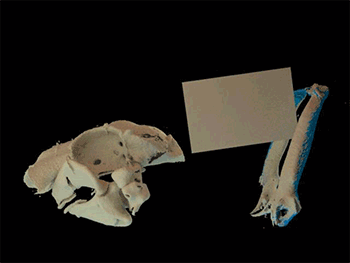These sharks get help swallowing from their shoulders
Swinging their pectoral bones forward and back moves the sharks’ food along

The white-spotted bamboo shark uses its shoulders to help slurp up unsuspecting prey.
yvonne n/Wikimedia Commons (CC BY 2.0)
Share this:
- Share via email (Opens in new window) Email
- Click to share on Facebook (Opens in new window) Facebook
- Click to share on X (Opens in new window) X
- Click to share on Pinterest (Opens in new window) Pinterest
- Click to share on Reddit (Opens in new window) Reddit
- Share to Google Classroom (Opens in new window) Google Classroom
- Click to print (Opens in new window) Print
Slurp in, and work those shoulders. It might not be glamorous, but that’s how one species of shark gets its dinner. A white-spotted bamboo shark doesn’t rip its prey apart. Instead, it opens its mouth very wide, very fast. The sudden movement creates suction, bringing water — and any food within it — into the shark’s hungry maw. But to move the food farther down toward the stomach, the mouth needs a little help. Some of that comes from a movement of the shark’s “shoulders,” a new study shows.
In people, shoulders are where the arms attach. Sharks have pectoral fins instead of arms, and instead of attaching to shoulders, those fins attach to a part of the skeleton called the pectoral girdle. This makes the pectoral girdle “kind of like the shoulders” of a shark, explains Ariel Camp. She studies biomechanics — or how living things move — at Brown University in Providence, R.I.
Because the pectoral fins are attached to the pectoral girdle, many scientists have studied this part of the shark skeleton to investigate how sharks swim. But no one had looked at a shark’s shoulders when it comes to feeding.
“Fish [including sharks] don’t have a tongue like we do,” Camp notes. Humans and other animals use a tongue to move food around in the mouth. Sharks instead probably “carefully control the flow of water in the mouth and use that to move food around,” she says. Camp wondered if the shark’s shoulders might help it control that water — and food — in their mouths.
Her team brought three white-spotted bamboo sharks into the lab. These reef sharks are long and narrow, growing to about 93 centimeters (37 inches) long. Using high-speed X-rays, they created a video of the hungry sharks’ skeletons as they were sucking up their food. Then they used the video to create a computer model of a what the skeleton does when a shark takes a bite.
As the shark’s mouth opens, water and any food rushes in. Then, the model showed, as the mouth begins to close, the pectoral girdle moves forward and back. “We found that they are swinging back a bit after the big suction event,” says Camp. So it seems, she says, that the shoulder shrugging is not helping as much to getting the food in the mouth as it is to moving food toward the stomach.

For two of the sharks, that movement was something like a reversed shrug. The pectoral girdle moved forward toward the shark’s head and then dropped back toward the stomach. Camp says the third shark, though, “did his own thing.” It just swung the shoulders backward. “I wouldn’t say [this motion is] replacing a swallow, but it is helping” move the food , she says. Camp and hercolleagues published their results July 26 in the journal Proceedings of the Royal Society B.
“This is very cool,” says Misty Paig-Tran. She’s a marine biologist who studies sharks at California State University in Fullerton. She was not involved in this study. “There’s still so much we don’t know about the basics of how organisms do what they do,” she says.
The new study shows that “similar anatomy can work in completely different ways,” Paig-Tran says. Sharks can use their shoulders for swimming. They can use them for feeding. Or they can work their shoulders both ways. The result, she explains, is that sharks use their belly muscles and shoulder muscles to gulp down some food.







